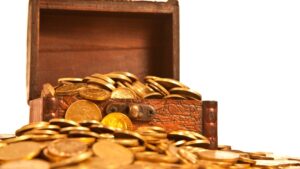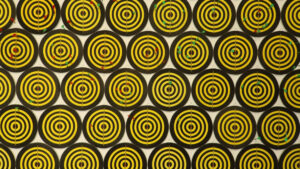Ground Breakers: Sleep easy, Canberra says our lithium earnings are poised to almost triple in FY23

Pic: Monica Click/iStock via Getty Images
- Canberra forecasters say we’ll pull in a record $450 billion in resources and energy earnings in FY23
- Lithium will be the big mover, up from ~$5bn to ~$14bn this financial year
- Markets go wild, with miners led by the gold and lithium sectors bathing in a sea of soothing green
Canberra says we’re going to pull in a record $450 billion in mining and energy exports in 2022-23, in a sign the boom cycle is yet to run its course.
That will be highly powered by record energy prices, with met and thermal coal collectively to account for $120 billion, slightly above iron ore at $119b.
LNG sales are expected to contribute $90b, up from $70b last year, when Australian exporters pulled in a total of $422 billion.
Total earnings are expected to fall to $375b in 2023-24 as iron ore, gas and coal prices soften, though that would still be the third biggest take on record.
Earnings could be higher still given thermal coal prices are showing little sign of slowing. Forecasters from the office of the chief economist in the Department of Industry, Science and Resources expect Newcastle Coal spot prices to fall from an average of US$333/t in 2022 to US$232/t in 2023.
They are currently in excess of US$400/t, with the potential for more supply disruptions heading into what could be a wet Australian summer.
But head further down the table and one commodity is making more inroads to line the pockets of Australian businesses and governments than any other, lithium.
With prices at record highs and companies incentivised to grow production, the value of Australia’s lithium industry is expected to climb from a little under $5 billion in FY22 to almost $14 billion in FY23.
Battery metals Australia’s future cash cow
For years iron ore, and at times coal and LNG, have been Australia’s cash cow, followed a long way back by the gold industry.
But battery metals such as lithium, copper and nickel are stepping in from the shadows.
Mined production of spodumene in Oz is expected to lift from 247,000t of lithium carbonate equivalent in FY21 and 335,000t in FY22 to 387,000t in FY23 and 469,000t in FY24.
Prices are not forecast to remain at current spot levels but are expected to remain high, averaging US$3280/t in 2023 and US$2490/t in 2024.
That is well above incentive pricing, with lithium hydroxide expected to average US$51,510/t in 2023 and US$37,650/t in 2024. That is far below current levels of US$70,000/t plus, but well above the doomsday scenario of US$16,000/t predicted by Goldman Sachs that spooked the industry back in May.
Spodumene exports totalled just $1.1b in FY21, signalling the rapid rise to prominence of the nascent industry.
Department analysts say whether lithium prices remain at record levels (spod averaged US$4,720/t on a 6% basis in August) is a battle between supply shortages and whether the push by refiners to secure materials was a result of supply chain fears.
“While expansions to production are already underway in Australia and overseas, there are long lead times for lithium mine and brine operations. Moreover, the potential for delays in bringing such large volumes of lithium into production, mean risks remain of persistent supply shortages over the next few years,” they said.
“However, one of the drivers of recent high spot prices appears to be a push by refiners and battery makers to build up inventories, due to concerns about global supply chains.
“The lack of data on global lithium stocks makes it difficult to judge how well battery producers have built up stockpiles. If these concerns ease, prices could moderate more rapidly over the outlook period.”
Lithium earnings will overtake copper sales this financial year, but those will remain a healthy $13.63b, while nickel and zinc are expected to deliver around $5b each, with the total suite of battery metals delivering around $38b.
They are forecast to remain steady in FY24, with battery metals potentially being worth as much to the Aussie economy as thermal coal if those prices come down as expected.
Golden years
Gold exports are also expected to rise, with a lift in mined production from the start of new operations and end of Covid restrictions to beef up sales from $23b to $26b in FY23.
However, in today’s September update both volumes and prices have been revised down for the next two years, with gold prices projected to fall from an average US$1788/oz in 2022 to US$1652/oz in 2023 and US$1614/oz in 2024.
That would see export values decline to $24.8b in 2023-24, even as production ramps up from 331t to 349t.
“The primary risk to the Australian gold production forecast is the extent to which supply chain issues and labour or skill shortages continue in the short term,” report authors wrote.
“A further downside risk to the forecasts of Australian gold production is weaker than expected gold prices. In this scenario, high-cost Australian producers would be expected to cease or cut back their operations.”
Gold, lithium miners surge
And to the markets where everyone is feeling pretty, pretty good as Larry David would say.
The ASX 200 is up 2.53%, in no small part thanks to a 3.35% lift in the materials index, where gold and lithium miners are leading a charge.
More broadly other sectors are in fine form as well, with uranium, coal and iron ore companies in the green.
Gold miners stuck out like a sore thumb though, given their struggles of late.
Treasury yields fell with investors starting to get a little rowdy about the prospects of US fiscal tightening easing.
Prices for bullion lifted 2.2% to a tick under US$1700/oz, having circled the US$1600/oz drain only a week ago, while silver lifted more than 8% to over US$20/oz.
Cue a run on gold, with Newcrest (ASX:NCM) and Northern Star (ASX:NST) up more than 5% each, St Barbara (ASX:SBM) up more than 7%, Capricorn Metals (ASX:CMM) lifting more than 8%, and De Grey (ASX:DEG), Regis (ASX:RRL), Perseus (ASX:PRU), Westgold (ASX:WGX), Gold Road (ASX:GOR) and Resolute (ASX:RSG) all big gainers.
Lithium miners Pilbara Minerals (ASX:PLS) and Allkem (ASX:AKE) ruled the roost in the large cap space, both up 7.25%, with IGO (ASX:IGO) also up almost 5%.
Ground Breakers share prices today:

UNLOCK INSIGHTS
Discover the untold stories of emerging ASX stocks.
Daily news and expert analysis, it's free to subscribe.
By proceeding, you confirm you understand that we handle personal information in accordance with our Privacy Policy.








